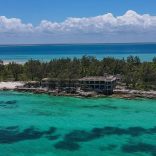Portuguese government wants to bolster cooperation, Hotel School in Mozambique
Mozambique, Brazil and Cape Verde loose international competitiveness

Maputo: Picture: Macauhub
Mozambique, Brazil and Cabo Verde (Cape Verde) have fallen back a few places in the latest edition of the Global Competitiveness Index of the World Economic Forum, in which Angola is in the lowest position among Portuguese-speaking countries (137th).
In the 2018 edition of the index, led by Switzerland (1st), the United States (2nd) and Singapore (3rd), Brazil fell three places from last year to 72nd out of 140 countries.
The strength of the largest economy in Latin America is the size of its market (10th largest in the world) and its weaknesses are macroeconomic stability (122nd worldwide), the labour market (114th) and business dynamism (108th).
Cabo Verde fell 6 places to 111th, appearing relatively well ranked in the financial system (75th) and institutions (79th), with the classification being penalised by factors such as market size (138th), capacity (137th) and business dynamism (131st).
Among the Portuguese-speaking countries, Mozambique had the worst evolution in the Index, a decline of eight places, with the greatest weaknesses being human capital (last place in the world), macroeconomic stability (137th) and health (135th).
The best indicators for Mozambique are the size of the market (10th) and business dynamism (104th).
Mozambique s rankedd 133rd out of 140 countries.
Unlike last year’s edition, the 2018 report includes Angola, which is ranked lowest among Portuguese-speaking countries, in 137th, only three places from the bottom of the table.
The Global Competitiveness Index noted that Angola’s biggest weaknesses are innovation capacity and the product market (both in last place) and macroeconomic stability (139th).
The most positive contribution to Angola’s performance is mainly from the size of the market (66th place).
Portugal, the most well-ranked Portuguese-speaking country, dropped slightly by one position to 33rd place.
According to the World Economic Forum, the strengths of the Portuguese economy are human capital, in particular health (23rd best globally) and the business environment, especially infrastructure (19th best in the world) and macroeconomic stability.
This year the report uses a new methodology “to fully capture the dynamics of the global economy in the Fourth Industrial Revolution, and many of the factors that will have the greatest impact on driving competitiveness in the future have never been the focus of major political decisions in the past,” which includes “building ideas, entrepreneurial culture, openness and agility.”
The new tool analyses the competitive landscape of 140 economies through 98 indicators organised into 12 pillars, indicating how close an economy is to the ideal state or the “frontier” of competitiveness.
When these factors are combined, the United States achieves the best overall score of 85.6 points, ahead of Singapore and Germany.
- Full 2018 Global Competitiveness Index of the World Economic Forum HERE












Leave a Reply
Be the First to Comment!
You must be logged in to post a comment.
You must be logged in to post a comment.